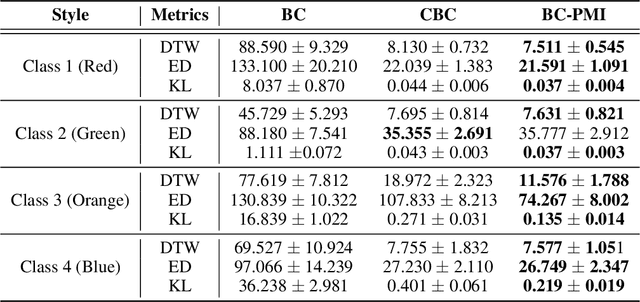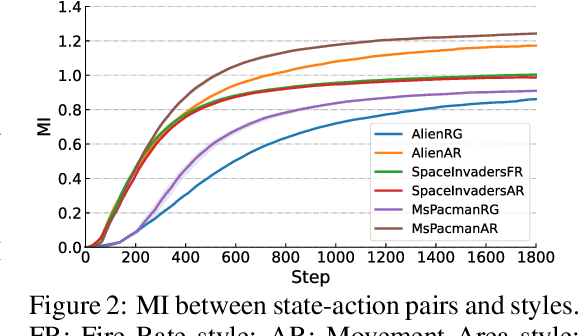Qiang Fu
Tencent Inc
Transforming Future Data Center Operations and Management via Physical AI
Apr 07, 2025Abstract:Data centers (DCs) as mission-critical infrastructures are pivotal in powering the growth of artificial intelligence (AI) and the digital economy. The evolution from Internet DC to AI DC has introduced new challenges in operating and managing data centers for improved business resilience and reduced total cost of ownership. As a result, new paradigms, beyond the traditional approaches based on best practices, must be in order for future data centers. In this research, we propose and develop a novel Physical AI (PhyAI) framework for advancing DC operations and management. Our system leverages the emerging capabilities of state-of-the-art industrial products and our in-house research and development. Specifically, it presents three core modules, namely: 1) an industry-grade in-house simulation engine to simulate DC operations in a highly accurate manner, 2) an AI engine built upon NVIDIA PhysicsNemo for the training and evaluation of physics-informed machine learning (PIML) models, and 3) a digital twin platform built upon NVIDIA Omniverse for our proposed 5-tier digital twin framework. This system presents a scalable and adaptable solution to digitalize, optimize, and automate future data center operations and management, by enabling real-time digital twins for future data centers. To illustrate its effectiveness, we present a compelling case study on building a surrogate model for predicting the thermal and airflow profiles of a large-scale DC in a real-time manner. Our results demonstrate its superior performance over traditional time-consuming Computational Fluid Dynamics/Heat Transfer (CFD/HT) simulation, with a median absolute temperature prediction error of 0.18 {\deg}C. This emerging approach would open doors to several potential research directions for advancing Physical AI in future DC operations.
Agents Play Thousands of 3D Video Games
Mar 17, 2025Abstract:We present PORTAL, a novel framework for developing artificial intelligence agents capable of playing thousands of 3D video games through language-guided policy generation. By transforming decision-making problems into language modeling tasks, our approach leverages large language models (LLMs) to generate behavior trees represented in domain-specific language (DSL). This method eliminates the computational burden associated with traditional reinforcement learning approaches while preserving strategic depth and rapid adaptability. Our framework introduces a hybrid policy structure that combines rule-based nodes with neural network components, enabling both high-level strategic reasoning and precise low-level control. A dual-feedback mechanism incorporating quantitative game metrics and vision-language model analysis facilitates iterative policy improvement at both tactical and strategic levels. The resulting policies are instantaneously deployable, human-interpretable, and capable of generalizing across diverse gaming environments. Experimental results demonstrate PORTAL's effectiveness across thousands of first-person shooter (FPS) games, showcasing significant improvements in development efficiency, policy generalization, and behavior diversity compared to traditional approaches. PORTAL represents a significant advancement in game AI development, offering a practical solution for creating sophisticated agents that can operate across thousands of commercial video games with minimal development overhead. Experiment results on the 3D video games are best viewed on https://zhongwen.one/projects/portal .
Optimizing Latent Goal by Learning from Trajectory Preference
Dec 03, 2024Abstract:A glowing body of work has emerged focusing on instruction-following policies for open-world agents, aiming to better align the agent's behavior with human intentions. However, the performance of these policies is highly susceptible to the initial prompt, which leads to extra efforts in selecting the best instructions. We propose a framework named Preference Goal Tuning (PGT). PGT allows an instruction following policy to interact with the environment to collect several trajectories, which will be categorized into positive and negative samples based on preference. Then we use preference learning to fine-tune the initial goal latent representation with the categorized trajectories while keeping the policy backbone frozen. The experiment result shows that with minimal data and training, PGT achieves an average relative improvement of 72.0% and 81.6% over 17 tasks in 2 different foundation policies respectively, and outperforms the best human-selected instructions. Moreover, PGT surpasses full fine-tuning in the out-of-distribution (OOD) task-execution environments by 13.4%, indicating that our approach retains strong generalization capabilities. Since our approach stores a single latent representation for each task independently, it can be viewed as an efficient method for continual learning, without the risk of catastrophic forgetting or task interference. In short, PGT enhances the performance of agents across nearly all tasks in the Minecraft Skillforge benchmark and demonstrates robustness to the execution environment.
Playable Game Generation
Dec 01, 2024



Abstract:In recent years, Artificial Intelligence Generated Content (AIGC) has advanced from text-to-image generation to text-to-video and multimodal video synthesis. However, generating playable games presents significant challenges due to the stringent requirements for real-time interaction, high visual quality, and accurate simulation of game mechanics. Existing approaches often fall short, either lacking real-time capabilities or failing to accurately simulate interactive mechanics. To tackle the playability issue, we propose a novel method called \emph{PlayGen}, which encompasses game data generation, an autoregressive DiT-based diffusion model, and a comprehensive playability-based evaluation framework. Validated on well-known 2D and 3D games, PlayGen achieves real-time interaction, ensures sufficient visual quality, and provides accurate interactive mechanics simulation. Notably, these results are sustained even after over 1000 frames of gameplay on an NVIDIA RTX 2060 GPU. Our code is publicly available: https://github.com/GreatX3/Playable-Game-Generation. Our playable demo generated by AI is: http://124.156.151.207.
Visual Adversarial Attack on Vision-Language Models for Autonomous Driving
Nov 27, 2024



Abstract:Vision-language models (VLMs) have significantly advanced autonomous driving (AD) by enhancing reasoning capabilities. However, these models remain highly vulnerable to adversarial attacks. While existing research has primarily focused on general VLM attacks, the development of attacks tailored to the safety-critical AD context has been largely overlooked. In this paper, we take the first step toward designing adversarial attacks specifically targeting VLMs in AD, exposing the substantial risks these attacks pose within this critical domain. We identify two unique challenges for effective adversarial attacks on AD VLMs: the variability of textual instructions and the time-series nature of visual scenarios. To this end, we propose ADvLM, the first visual adversarial attack framework specifically designed for VLMs in AD. Our framework introduces Semantic-Invariant Induction, which uses a large language model to create a diverse prompt library of textual instructions with consistent semantic content, guided by semantic entropy. Building on this, we introduce Scenario-Associated Enhancement, an approach where attention mechanisms select key frames and perspectives within driving scenarios to optimize adversarial perturbations that generalize across the entire scenario. Extensive experiments on several AD VLMs over multiple benchmarks show that ADvLM achieves state-of-the-art attack effectiveness. Moreover, real-world attack studies further validate its applicability and potential in practice.
Diverse Policies Recovering via Pointwise Mutual Information Weighted Imitation Learning
Oct 21, 2024



Abstract:Recovering a spectrum of diverse policies from a set of expert trajectories is an important research topic in imitation learning. After determining a latent style for a trajectory, previous diverse policies recovering methods usually employ a vanilla behavioral cloning learning objective conditioned on the latent style, treating each state-action pair in the trajectory with equal importance. Based on an observation that in many scenarios, behavioral styles are often highly relevant with only a subset of state-action pairs, this paper presents a new principled method in diverse polices recovery. In particular, after inferring or assigning a latent style for a trajectory, we enhance the vanilla behavioral cloning by incorporating a weighting mechanism based on pointwise mutual information. This additional weighting reflects the significance of each state-action pair's contribution to learning the style, thus allowing our method to focus on state-action pairs most representative of that style. We provide theoretical justifications for our new objective, and extensive empirical evaluations confirm the effectiveness of our method in recovering diverse policies from expert data.
HazyDet: Open-source Benchmark for Drone-view Object Detection with Depth-cues in Hazy Scenes
Sep 30, 2024



Abstract:Drone-based object detection in adverse weather conditions is crucial for enhancing drones' environmental perception, yet it remains largely unexplored due to the lack of relevant benchmarks. To bridge this gap, we introduce HazyDet, a large-scale dataset tailored for drone-based object detection in hazy scenes. It encompasses 383,000 real-world instances, collected from both naturally hazy environments and normal scenes with synthetically imposed haze effects to simulate adverse weather conditions. By observing the significant variations in object scale and clarity under different depth and haze conditions, we designed a Depth Conditioned Detector (DeCoDet) to incorporate this prior knowledge. DeCoDet features a Multi-scale Depth-aware Detection Head that seamlessly integrates depth perception, with the resulting depth cues harnessed by a dynamic Depth Condition Kernel module. Furthermore, we propose a Scale Invariant Refurbishment Loss to facilitate the learning of robust depth cues from pseudo-labels. Extensive evaluations on the HazyDet dataset demonstrate the flexibility and effectiveness of our method, yielding significant performance improvements. Our dataset and toolkit are available at https://github.com/GrokCV/HazyDet.
Hokoff: Real Game Dataset from Honor of Kings and its Offline Reinforcement Learning Benchmarks
Aug 20, 2024



Abstract:The advancement of Offline Reinforcement Learning (RL) and Offline Multi-Agent Reinforcement Learning (MARL) critically depends on the availability of high-quality, pre-collected offline datasets that represent real-world complexities and practical applications. However, existing datasets often fall short in their simplicity and lack of realism. To address this gap, we propose Hokoff, a comprehensive set of pre-collected datasets that covers both offline RL and offline MARL, accompanied by a robust framework, to facilitate further research. This data is derived from Honor of Kings, a recognized Multiplayer Online Battle Arena (MOBA) game known for its intricate nature, closely resembling real-life situations. Utilizing this framework, we benchmark a variety of offline RL and offline MARL algorithms. We also introduce a novel baseline algorithm tailored for the inherent hierarchical action space of the game. We reveal the incompetency of current offline RL approaches in handling task complexity, generalization and multi-task learning.
Latent Space Imaging
Jul 09, 2024Abstract:Digital imaging systems have classically been based on brute-force measuring and processing of pixels organized on regular grids. The human visual system, on the other hand, performs a massive data reduction from the number of photo-receptors to the optic nerve, essentially encoding the image information into a low bandwidth latent space representation suitable for processing by the human brain. In this work, we propose to follow a similar approach for the development of artificial vision systems. Latent Space Imaging is a new paradigm that, through a combination of optics and software, directly encodes the image information into the semantically rich latent space of a generative model, thus substantially reducing bandwidth and memory requirements during the capture process. We demonstrate this new principle through an initial hardware prototype based on the single pixel camera. By designing an amplitude modulation scheme that encodes into the latent space of a generative model, we achieve compression ratios from 1:100 to 1:1,000 during the imaging process, illustrating the potential of latent space imaging for highly efficient imaging hardware, to enable future applications in high speed imaging, or task-specific cameras with substantially reduced hardware complexity.
Hallucination Detection: Robustly Discerning Reliable Answers in Large Language Models
Jul 04, 2024Abstract:Large Language Models (LLMs) have gained widespread adoption in various natural language processing tasks, including question answering and dialogue systems. However, a major drawback of LLMs is the issue of hallucination, where they generate unfaithful or inconsistent content that deviates from the input source, leading to severe consequences. In this paper, we propose a robust discriminator named RelD to effectively detect hallucination in LLMs' generated answers. RelD is trained on the constructed RelQA, a bilingual question-answering dialogue dataset along with answers generated by LLMs and a comprehensive set of metrics. Our experimental results demonstrate that the proposed RelD successfully detects hallucination in the answers generated by diverse LLMs. Moreover, it performs well in distinguishing hallucination in LLMs' generated answers from both in-distribution and out-of-distribution datasets. Additionally, we also conduct a thorough analysis of the types of hallucinations that occur and present valuable insights. This research significantly contributes to the detection of reliable answers generated by LLMs and holds noteworthy implications for mitigating hallucination in the future work.
 Add to Chrome
Add to Chrome Add to Firefox
Add to Firefox Add to Edge
Add to Edge